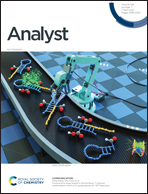Optimization of signal amplification by reversible exchange for polarization of tridentate chelating bis[(2-pyridyl)alkyl]amine†
Abstract
Signal amplification by reversible exchange (SABRE) is an effective NMR hyperpolarization technique for signal enhancement using para-hydrogen on iridium catalysts. To date, monodentate chelating nitrogen analogs have been predominantly used as substrates for SABRE because of the limited chelating sites of the Ir-catalyst with different molecular orientations. Herein, for the first time, the use of a tridentate chelating ligand (BPEA) containing pyridine moieties and a secondary amine as a SABRE substrate is demonstrated. For the optimization of the tridentate chelating ligand, alkyl chain lengths were varied with the optimization of the external magnetic field and concentrations of three different ligands. Because many chemically multidentate complexes present in nature have scarcely been studied as SABRE substrates, this optimized tridentate chelating ligand structure with the SABRE catalyst and its polarization transfer from para-hydrogen will broaden the scope of hyperpolarizable substrates and help in the investigation of chelating structures for future applications.
![Graphical abstract: Optimization of signal amplification by reversible exchange for polarization of tridentate chelating bis[(2-pyridyl)alkyl]amine](/en/Image/Get?imageInfo.ImageType=GA&imageInfo.ImageIdentifier.ManuscriptID=D0AN02372H&imageInfo.ImageIdentifier.Year=2021)


 Please wait while we load your content...
Please wait while we load your content...